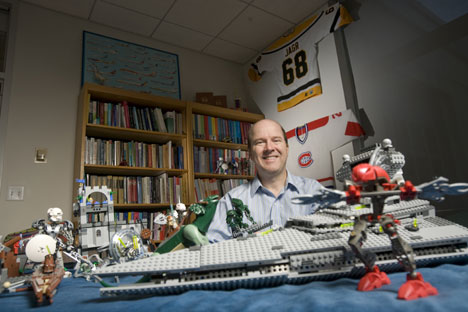
Though his distinguished research career on making supercomputers better has taken him from higher education to a research institute to a fast-growing private company, it's students that bring Bruce Maggs back to the university.
"I like to say the best thing about being a professor is that you eventually get the thorough undergraduate education in your subject that you thought you had when you graduated from college yourself," said Maggs, who joined Duke's computer science department as a full professor in July. "Students keep you on your toes, and I still learn an amazing amount in the process."
His career path could have been different, since Maggs is the son, grandson and brother of law professors. His grandfather Douglas Maggs was a Duke law school professor, and his father grew up in Durham. Bruce Maggs, however, grew up in Yugoslavia, Bulgaria, Romania and the Soviet Union while his dad pursued a specialty in Soviet law.
It was his father's hobby while teaching at the University of Illinois at Urbana-Champaign in the 1970s that led Bruce Maggs to computer science. The family acquired an ahead-of-its-time computer system known as PLATO. "PLATO had things like instant messaging, chat and newsgroups and email," Maggs said. "But most important for me, it also had highly interactive, multiplayer games."
The young Maggs got so good at writing game programs that he decided it was "pointless" to major in computer science when he enrolled at the University of Illinois in 1981. He was "promptly humbled" to learn otherwise, he said.
He transferred from Illinois to MIT in 1983 to finish his bachelor's degree and continue as a graduate student and a post-doctoral investigator. At MIT, he made contributions to the theory of "fat-tree" interconnections that speed signals around parallel computing systems that rely on multiple processors working simultaneously.
Fat-tree architectures can be found in the Thinking Machines CM-5 supercomputer that Duke once hosted to the huge server arrays that keep Google answering the world's questions.
His first full-time job after MIT was at the NEC Research Institute in Princeton, N.J., a computing think tank.

While working on ways to help programmers work around system failures by creating a failure-free "model" network, he also started teaching courses at Princeton and discovered that he really liked working with students.
Maggs joined the faculty of Carnegie Mellon University in 1994, where he spent the next 15 years teaching and moving his research from theorizing about parallel processing to working with real networks and designing systems.
In 1998, Maggs began consulting for a startup firm called Akamai Technologies and soon became full-time vice president for research and development. As the company found a niche managing the dispersed servers that do things such as displaying book offerings for Amazon or delivering software updates for Microsoft, Maggs' role expanded as well.
"One day I found I had 140 people reporting to me,' he recalled. "I really hadn't intended to become a manager, so in 2000 I went back to Carnegie Mellon." He remains Akamai's part-time vice president for research.
Maggs first came to Duke two years ago as a visiting professor, and for a while he commuted between Durham and Pittsburgh. But the travel interfered with his research and teaching. "The computer science department here was extremely friendly, gracious and generous to me from the first day I said I might be interested in coming here full time," he said.
His Levine Science Center office displays an unprofessorial collection of Lego blocks, "I always tell people they are my eight year old son's, but he'll tell you the truth," said Maggs, who also has two stepsons, aged 14 and 17.
There is also display of ice hockey paraphernalia. He plays with relish two nights a week on two different teams in Hillsborough. And, in a gesture to his profession, there is a framed rendering of the "only chip I ever made," he said. It's part of a fat-tree network.